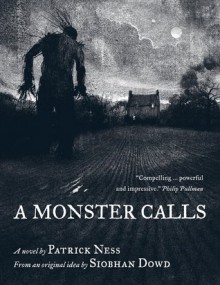
What is there to like?
▪ Throughout the book, Conor experiences some dark emotions…shame, emptiness, a need for destruction, and especially anger—towards himself, others for alienating him, the school bully, and his family—and also deep, deep sorrow. But the reader is swept up in Conor’s feelings and experiences them with him—there’s never a distance that makes the reader fear or disconnect from Conor, which is really important for finding the real strength of this story. Patrick Ness has done an outstanding job of capturing powerful, true emotions in an empathetic protagonist.
▪ Illustrator Jim Kay's art is every bit as much a part of the storytelling as the words, and it is dark and rich and textured and evocative, and worth poring over.
▪ The stories-within-the-story device is pretty commonplace, and readers may share Conor’s initial skepticism at first—but these stories are unexpected, and quickly prove their value.
▪ Excellent, true-to-life cast of characters in Conor’s go-get-’em grandmother, distant father, the school faculty who handle him like an exotic, fragile object they’re not sure what to do with, and the “bully with charisma and top marks” who will “probably end up Prime Minister one day. God help us all.”
▪ The personification of the monster through his language, stories, and the art—and the eventual blurring of Conor with the monster, also make this book memorable.
▪ This is a book that you need to pick up with your hands and read. Everything about the design is gorgeous—from the art itself to the way the art spreads across the page and mingles with the text to the unusual trim size to the weight of the book in your hand. It’s a beautiful book that exemplifies how tactile and visual components of design contribute to the reading experience.
What's not to like?
There's really nothing that I didn't like about the book itself, but Sara raises a good point about audience that I was wondering about as well.
Similar To:
The Pricker Boy, Reade Scott Whinnem
The Book of Lost Things, John Connolly
Gossamer, Lois Lowry
The Graveyard Book, Neil Gaiman (in that the art reminded me of Dave McKean’s, at times)
What made me pick it up?
It’s been on my to-read list for ages, and I saw it on the library shelf when I was picking up another “N” author.
Overall Recommendation: Essential reading. This is one of the most powerful, well-crafted books I’ve read in quite a while.

 Log in with Facebook
Log in with Facebook 





